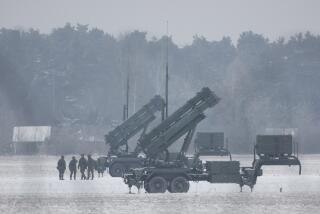Cost of U.S. Weapon Programs Drops by $323 Million in 1986, Pentagon Says
- Share via
WASHINGTON — The estimated cost of U.S. primary weapon programs declined by $323 million in the first six months of the year, mainly because of the cancellation of an Air Force radar detection system, the Pentagon said Friday.
In a congressionally mandated report, the Pentagon said it now expects the 95 weapon programs that form the heart of President Reagan’s military buildup to cost $763.62 billion to complete.
That is down $323 million from a December, 1985, estimate of $763.94 billion.
The Pentagon said that the decline was “primarily attributed to the cancellation of the Precision Location Strike System production program.”
That program involved development and production of new electronic gear that could be placed on high-flying TR-1 reconnaissance jets and used to pinpoint enemy radar installations by locking on their radio emissions.
The program, plagued by problems in developing its computer programs, was canceled by the Air Force last April.
The latest report also lists savings in three other programs--the Navy’s MK-50 torpedo, the Defense Satellite Communication System and a new integrated computer data transmission system--totaling $53.6 million. Those savings are mostly due to refinement of estimates based on work done to date and reduction in support costs.
The various savings, however, were offset to some extent by increases in the projected cost of two new weapons--the C-17 transport plane and the Sensor Fuzed Weapon, a new type of precision-guided bomb.
The report indicates that the estimated cost of acquiring 211 C-17’s has risen $33.5 million to $34.52 billion, while the cost of procuring 14,085 of the new bombs has climbed $71.3 million to $2.4 billion.
More to Read
Sign up for Essential California
The most important California stories and recommendations in your inbox every morning.
You may occasionally receive promotional content from the Los Angeles Times.













